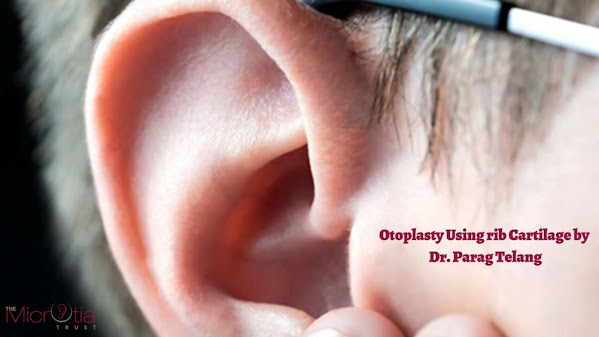Otoplasty Using rib Cartilage by Dr. Parag Telang
A cosmetic surgical procedure called otoplasty, also called "ear reshaping surgery," aims to enhance the appearance of the ears. It is typically carried out on people who are unhappy with the size, position, or shape of their ears, as well as those who have experienced trauma or have a congenital defect.
As we talk to the patients, they say that the first thing they look for while choosing a surgeon is to find an otoplasty surgery near me Although proximity to a doctor is one of the main aspects, but choosing a qualified and experienced surgeon is equally crucial for otoplasty. Prior to the procedure, one should have a thorough consultation with the surgeon to go over their expectations as well as any possible risks or complications.
Both children and adults are candidates for otoplasty, which is frequently used to treat conditions like:
Protruding or prominent ears
Large or asymmetrical ears
Abnormally shaped ears
Congenital ear deformities
How is otoplasty using rib cartilage performed?
For patients with protruding ears, severe ear deformities, congenital defects, or those who have had previous unsuccessful otoplasty surgeries, rib cartilage reconstruction is the best surgical technique.
The procedure begins with the surgeon making a small incision in the chest area to remove a small piece of rib cartilage.
After that, the cartilage is carved and molded to fit the patient's unique ear anatomy and deformity.
In order to access the cartilage, the surgeon first makes an incision behind the ear.
After carefully inserting the carved rib cartilage into the ear, the surgeon can then reshape it. Sutures are used to hold the cartilage in place, and the incisions are then stitched up.
Compared to conventional otoplasty procedures, this technique may require a longer recovery period for patients because it involves both chest and ear surgery.
Patients who undergo otoplasty with rib cartilage may need to wear a protective headband or dressing for several weeks and may need to avoid certain activities for a longer period of time to promote healing and minimize the risk of complications. After surgery, most patients can go back to work or school in a week, but they should avoid strenuous activities for a few weeks.
What are the risks involved in otoplasty surgery?
Like any surgical procedure, otoplasty carries some risks and potential complications, although they are relatively rare. Some of the possible risks associated with otoplasty surgery include:
Infection: Infection can occur after any surgical procedure, and otoplasty is no exception. To avoid any kind of infection it is a must to follow all the guidelines given by the doctor.
Bleeding: Some bleeding is normal after otoplasty surgery, but excessive bleeding can occur in rare cases. The surgeon will monitor the patient closely during and after the procedure to ensure that bleeding is kept to a minimum.
Scarring: Scarring can occur after any surgical procedure, including otoplasty. However, if performed by a skilled surgeon, scarring is usually minimal because the incisions made during otoplasty are usually small and hidden behind the ear.
Numbness: Temporary numbness in the ear or surrounding areas can occur after otoplasty surgery. This is usually temporary and resolves on its own within a few weeks or months.
Asymmetry: In rare cases, the results of otoplasty may not be symmetrical, meaning that one ear may appear different than the other. Only a skilled surgeon can work on the details and avoid the asymmetry of the ears.
It is important to discuss these risks and any other concerns one may have with the surgeon before undergoing otoplasty surgery. The surgeon will take steps to minimize these risks and ensure the best possible outcome for the patient.
Can one pierce an ear after the otoplasty procedure?
It is generally recommended that one wait at least six months after otoplasty surgery before getting their ears pierced. This allows enough time for the ears to fully heal and for the incisions to completely close.
Piercing the ears too soon after surgery can increase the risk of infection and potentially affect the results of the surgery. In addition, putting the earring back in place puts pressure and tension on the ear, which has the potential to harm the cartilage or rip apart the sutures used for the otoplasty procedure.
It's crucial to talk with the surgeon in advance if one plans to get the ears pierced after otoplasty surgery. They can advise the patient on when it is safe to get the ears pierced and can give specific recommendations based on their unique circumstances.
Can otoplasty affect hearing?
Otoplasty is a surgical procedure that aims to reshape the outer ear and shouldn't impair hearing. However, the actual hearing mechanism is located deeper inside the ear, in the middle and inner ear. The external ear (pinna or auricle) plays a role in gathering sound waves and directing them into the ear canal.
The internal ear structures that control hearing are carefully protected during otoplasty to prevent harm or modification. One should consult the surgeon if they have any worries about the hearing before or after the procedure to address any potential problems.
Why Dr. Parag Telang?
Dr. Parag Telang is a world-renowned surgeon for microtia and ear deformities and is considered to be the best ear surgeon in India. He is the founder of “The Microtia Trust”, the best ear reconstruction surgery clinic which provides a wide range of treatments for ear deformities to patients suffering from microtia, both external and internal ear deformities, prominent ears, and ear loss after injury or burns. Patients come from all around the world to avail benefits of his innovative approach to treatment, compassionate care, and surgical skills that help one to achieve the best-desired results. He has treated many international patients from the USA, UAE, Europe, London, and from across the globe and corrected their ear-associated problems like microtia and both external and internal ear deformities.



Comments
Post a Comment